Holmesglen Semester 2 BAC301: Advance Financial Accounting Assignment
VerifiedAdded on 2023/06/03
|7
|1465
|251
Homework Assignment
AI Summary
This assignment solution provides a detailed analysis of key concepts in advance financial accounting, based on AASB 121. It begins by differentiating between monetary and non-monetary items, explaining their characteristics and providing examples. The solution then delves into the accounting treatment for foreign currency monetary items, including initial recognition and translation at the reporting period end. A significant portion of the assignment addresses the difference in accounting treatment between qualifying and other foreign currency monetary items, particularly concerning qualifying assets. Finally, the solution explains the reasons for reversing gains recognized from the sale of assets during consolidation, highlighting the impact on consolidated financial statements. The document references relevant accounting standards and provides a clear understanding of the concepts discussed.
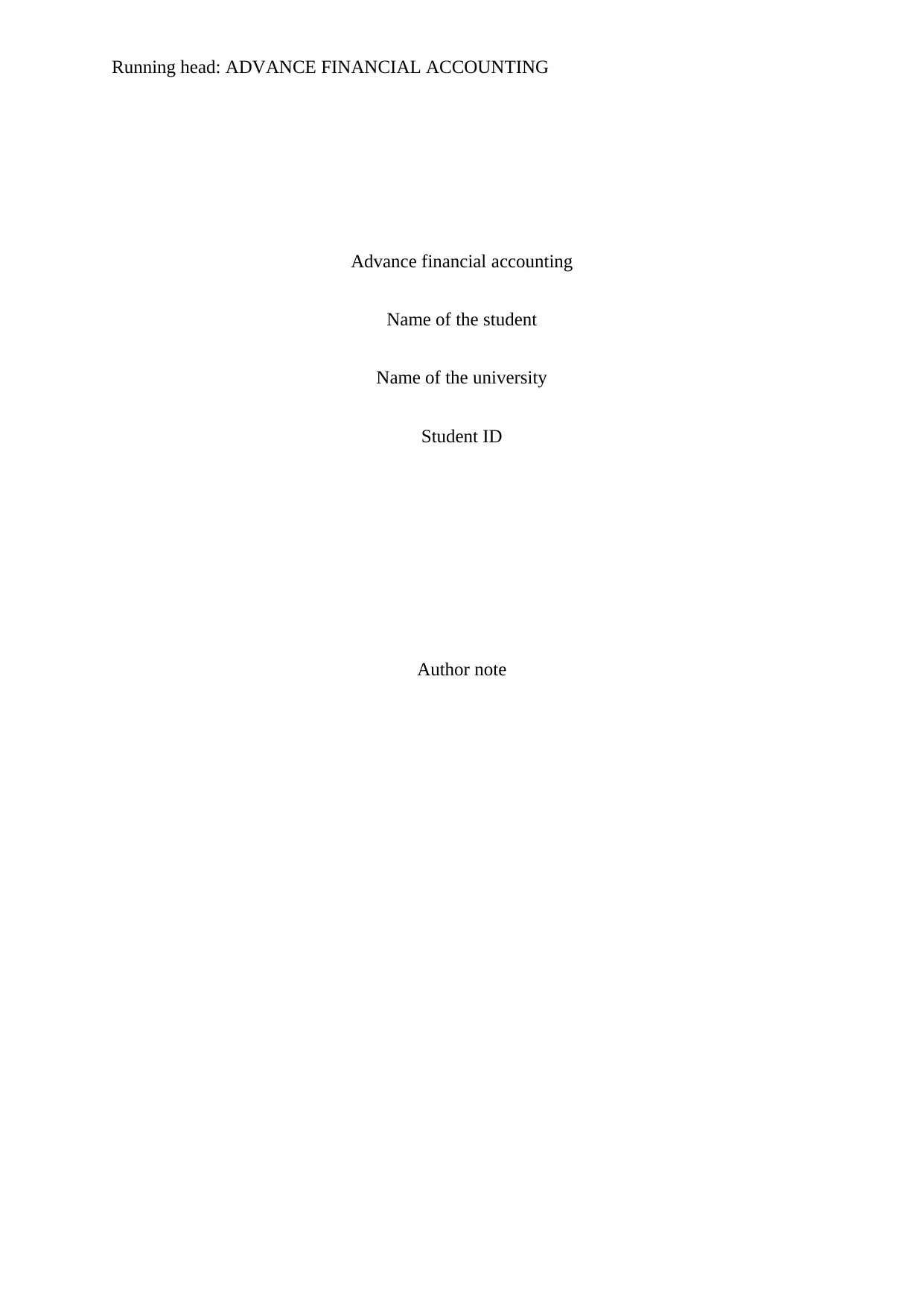
Running head: ADVANCE FINANCIAL ACCOUNTING
Advance financial accounting
Name of the student
Name of the university
Student ID
Author note
Advance financial accounting
Name of the student
Name of the university
Student ID
Author note
Paraphrase This Document
Need a fresh take? Get an instant paraphrase of this document with our AI Paraphraser
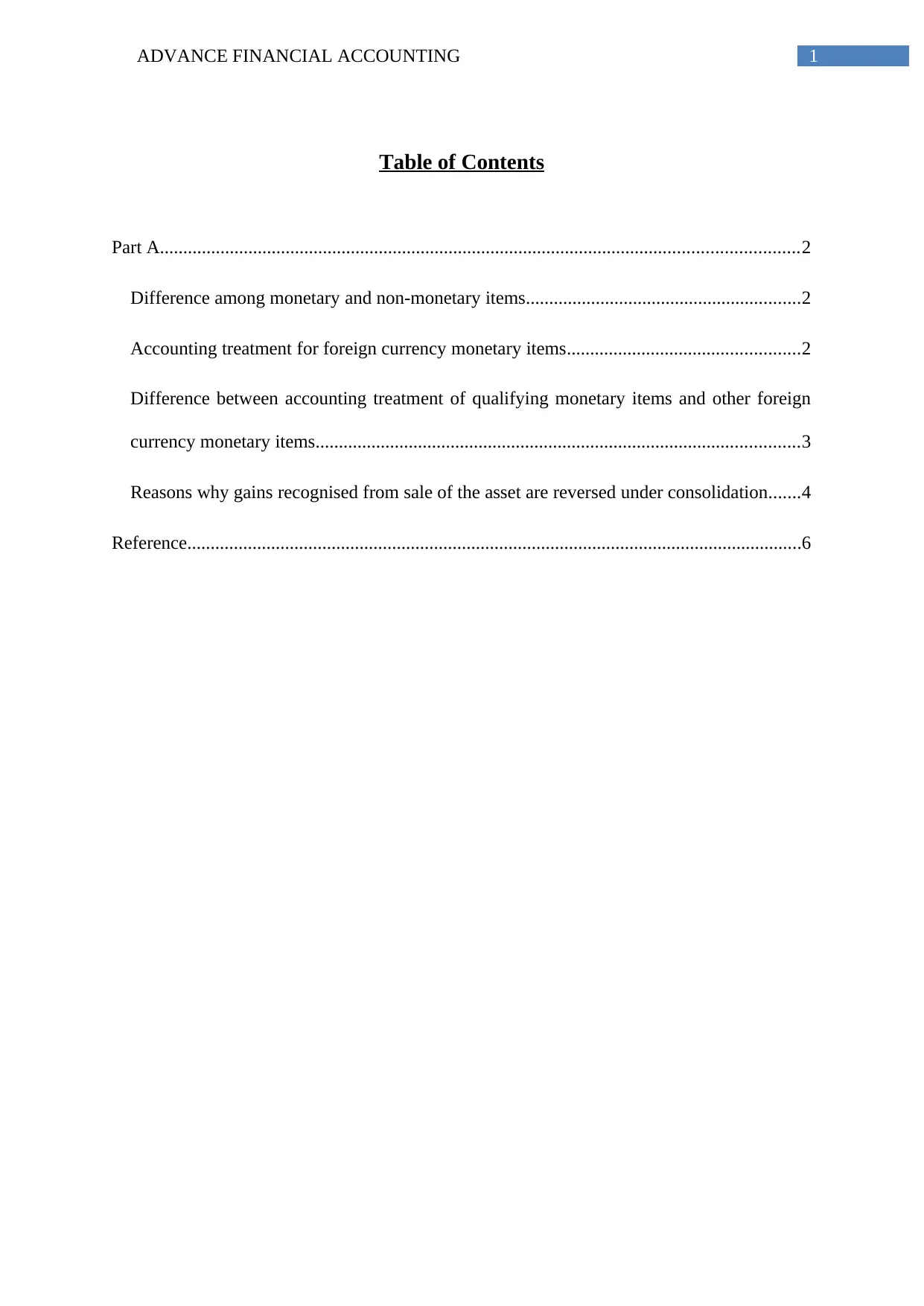
1ADVANCE FINANCIAL ACCOUNTING
Table of Contents
Part A.........................................................................................................................................2
Difference among monetary and non-monetary items...........................................................2
Accounting treatment for foreign currency monetary items..................................................2
Difference between accounting treatment of qualifying monetary items and other foreign
currency monetary items........................................................................................................3
Reasons why gains recognised from sale of the asset are reversed under consolidation.......4
Reference....................................................................................................................................6
Table of Contents
Part A.........................................................................................................................................2
Difference among monetary and non-monetary items...........................................................2
Accounting treatment for foreign currency monetary items..................................................2
Difference between accounting treatment of qualifying monetary items and other foreign
currency monetary items........................................................................................................3
Reasons why gains recognised from sale of the asset are reversed under consolidation.......4
Reference....................................................................................................................................6
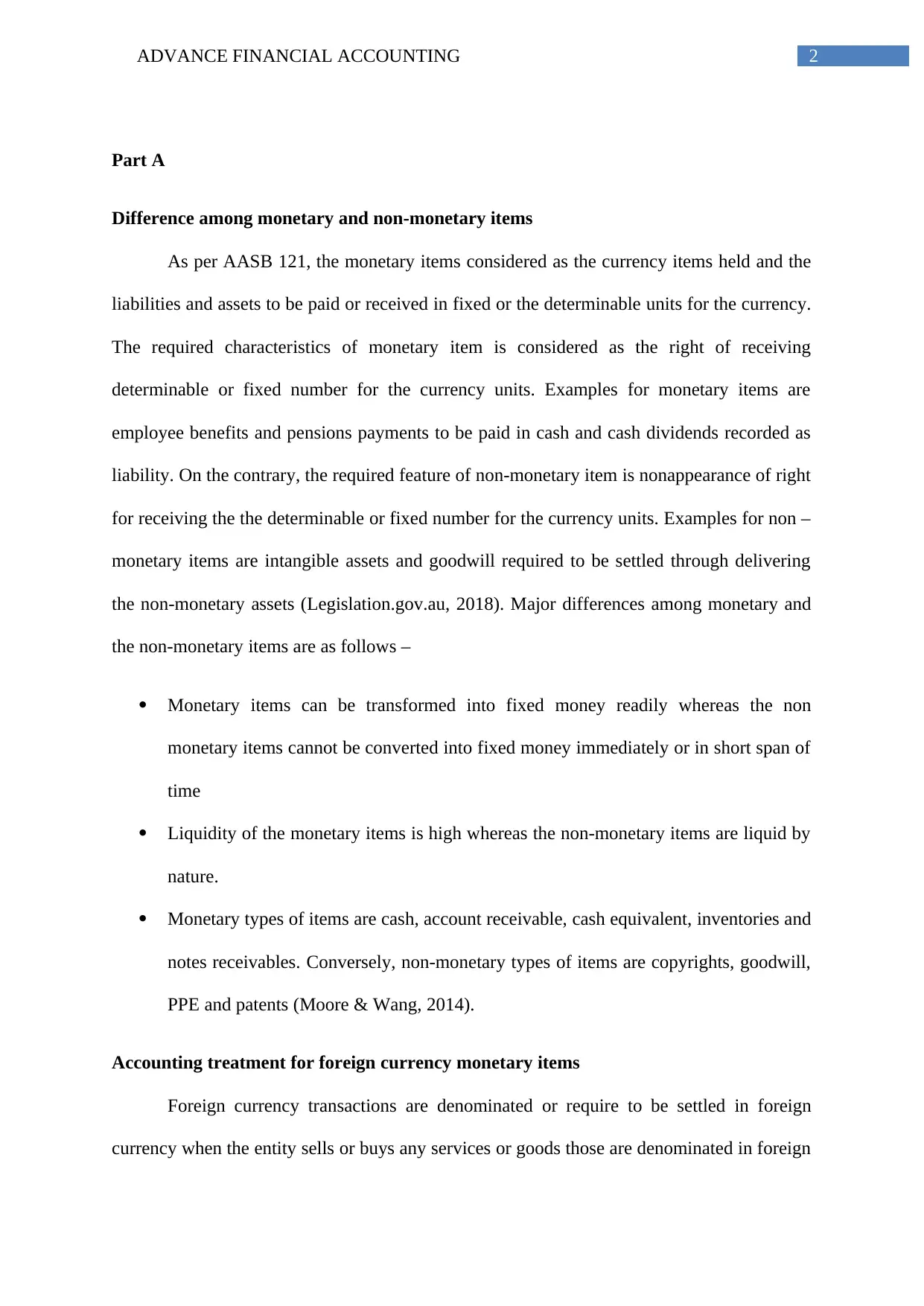
2ADVANCE FINANCIAL ACCOUNTING
Part A
Difference among monetary and non-monetary items
As per AASB 121, the monetary items considered as the currency items held and the
liabilities and assets to be paid or received in fixed or the determinable units for the currency.
The required characteristics of monetary item is considered as the right of receiving
determinable or fixed number for the currency units. Examples for monetary items are
employee benefits and pensions payments to be paid in cash and cash dividends recorded as
liability. On the contrary, the required feature of non-monetary item is nonappearance of right
for receiving the the determinable or fixed number for the currency units. Examples for non –
monetary items are intangible assets and goodwill required to be settled through delivering
the non-monetary assets (Legislation.gov.au, 2018). Major differences among monetary and
the non-monetary items are as follows –
Monetary items can be transformed into fixed money readily whereas the non
monetary items cannot be converted into fixed money immediately or in short span of
time
Liquidity of the monetary items is high whereas the non-monetary items are liquid by
nature.
Monetary types of items are cash, account receivable, cash equivalent, inventories and
notes receivables. Conversely, non-monetary types of items are copyrights, goodwill,
PPE and patents (Moore & Wang, 2014).
Accounting treatment for foreign currency monetary items
Foreign currency transactions are denominated or require to be settled in foreign
currency when the entity sells or buys any services or goods those are denominated in foreign
Part A
Difference among monetary and non-monetary items
As per AASB 121, the monetary items considered as the currency items held and the
liabilities and assets to be paid or received in fixed or the determinable units for the currency.
The required characteristics of monetary item is considered as the right of receiving
determinable or fixed number for the currency units. Examples for monetary items are
employee benefits and pensions payments to be paid in cash and cash dividends recorded as
liability. On the contrary, the required feature of non-monetary item is nonappearance of right
for receiving the the determinable or fixed number for the currency units. Examples for non –
monetary items are intangible assets and goodwill required to be settled through delivering
the non-monetary assets (Legislation.gov.au, 2018). Major differences among monetary and
the non-monetary items are as follows –
Monetary items can be transformed into fixed money readily whereas the non
monetary items cannot be converted into fixed money immediately or in short span of
time
Liquidity of the monetary items is high whereas the non-monetary items are liquid by
nature.
Monetary types of items are cash, account receivable, cash equivalent, inventories and
notes receivables. Conversely, non-monetary types of items are copyrights, goodwill,
PPE and patents (Moore & Wang, 2014).
Accounting treatment for foreign currency monetary items
Foreign currency transactions are denominated or require to be settled in foreign
currency when the entity sells or buys any services or goods those are denominated in foreign
⊘ This is a preview!⊘
Do you want full access?
Subscribe today to unlock all pages.

Trusted by 1+ million students worldwide
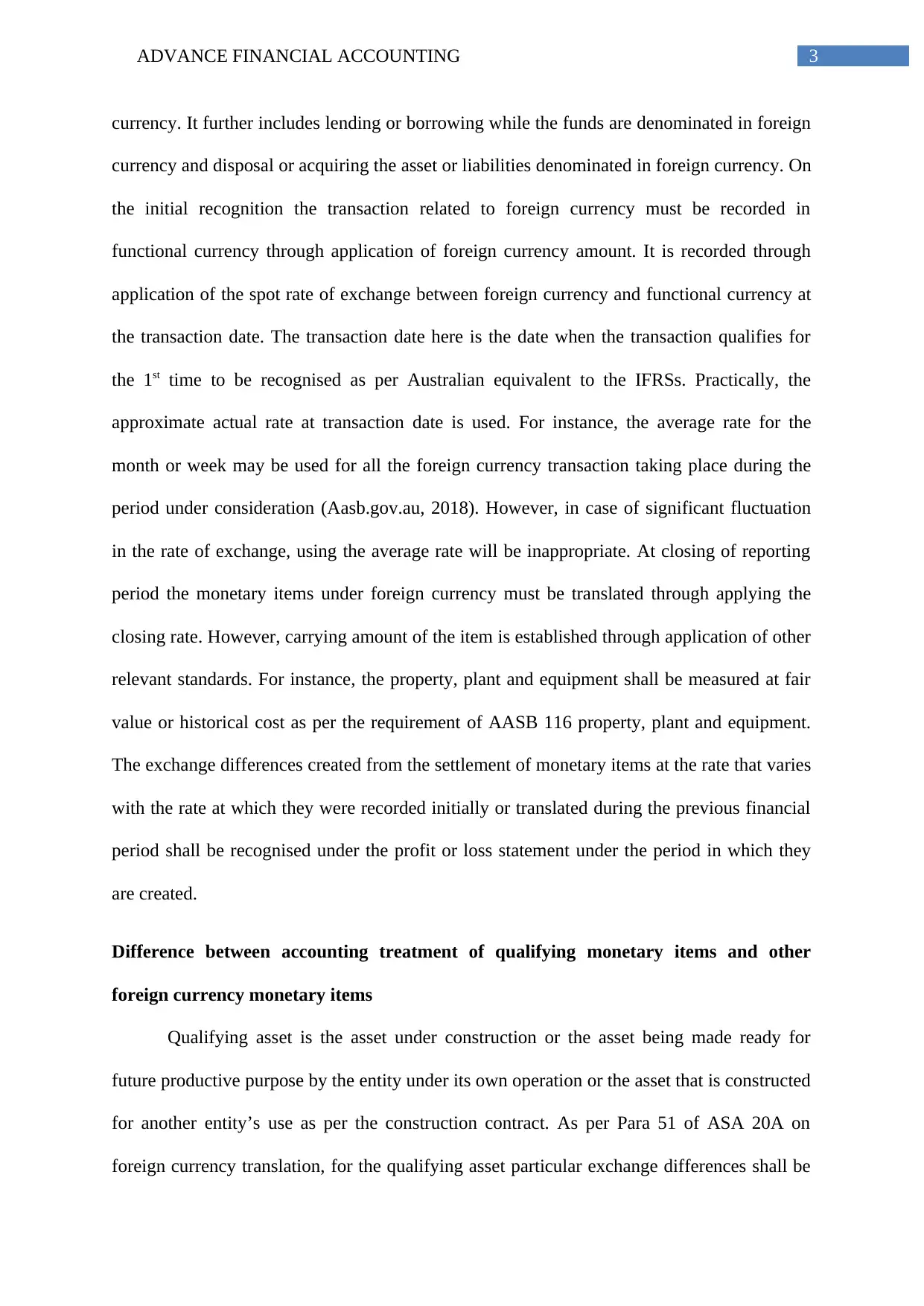
3ADVANCE FINANCIAL ACCOUNTING
currency. It further includes lending or borrowing while the funds are denominated in foreign
currency and disposal or acquiring the asset or liabilities denominated in foreign currency. On
the initial recognition the transaction related to foreign currency must be recorded in
functional currency through application of foreign currency amount. It is recorded through
application of the spot rate of exchange between foreign currency and functional currency at
the transaction date. The transaction date here is the date when the transaction qualifies for
the 1st time to be recognised as per Australian equivalent to the IFRSs. Practically, the
approximate actual rate at transaction date is used. For instance, the average rate for the
month or week may be used for all the foreign currency transaction taking place during the
period under consideration (Aasb.gov.au, 2018). However, in case of significant fluctuation
in the rate of exchange, using the average rate will be inappropriate. At closing of reporting
period the monetary items under foreign currency must be translated through applying the
closing rate. However, carrying amount of the item is established through application of other
relevant standards. For instance, the property, plant and equipment shall be measured at fair
value or historical cost as per the requirement of AASB 116 property, plant and equipment.
The exchange differences created from the settlement of monetary items at the rate that varies
with the rate at which they were recorded initially or translated during the previous financial
period shall be recognised under the profit or loss statement under the period in which they
are created.
Difference between accounting treatment of qualifying monetary items and other
foreign currency monetary items
Qualifying asset is the asset under construction or the asset being made ready for
future productive purpose by the entity under its own operation or the asset that is constructed
for another entity’s use as per the construction contract. As per Para 51 of ASA 20A on
foreign currency translation, for the qualifying asset particular exchange differences shall be
currency. It further includes lending or borrowing while the funds are denominated in foreign
currency and disposal or acquiring the asset or liabilities denominated in foreign currency. On
the initial recognition the transaction related to foreign currency must be recorded in
functional currency through application of foreign currency amount. It is recorded through
application of the spot rate of exchange between foreign currency and functional currency at
the transaction date. The transaction date here is the date when the transaction qualifies for
the 1st time to be recognised as per Australian equivalent to the IFRSs. Practically, the
approximate actual rate at transaction date is used. For instance, the average rate for the
month or week may be used for all the foreign currency transaction taking place during the
period under consideration (Aasb.gov.au, 2018). However, in case of significant fluctuation
in the rate of exchange, using the average rate will be inappropriate. At closing of reporting
period the monetary items under foreign currency must be translated through applying the
closing rate. However, carrying amount of the item is established through application of other
relevant standards. For instance, the property, plant and equipment shall be measured at fair
value or historical cost as per the requirement of AASB 116 property, plant and equipment.
The exchange differences created from the settlement of monetary items at the rate that varies
with the rate at which they were recorded initially or translated during the previous financial
period shall be recognised under the profit or loss statement under the period in which they
are created.
Difference between accounting treatment of qualifying monetary items and other
foreign currency monetary items
Qualifying asset is the asset under construction or the asset being made ready for
future productive purpose by the entity under its own operation or the asset that is constructed
for another entity’s use as per the construction contract. As per Para 51 of ASA 20A on
foreign currency translation, for the qualifying asset particular exchange differences shall be
Paraphrase This Document
Need a fresh take? Get an instant paraphrase of this document with our AI Paraphraser
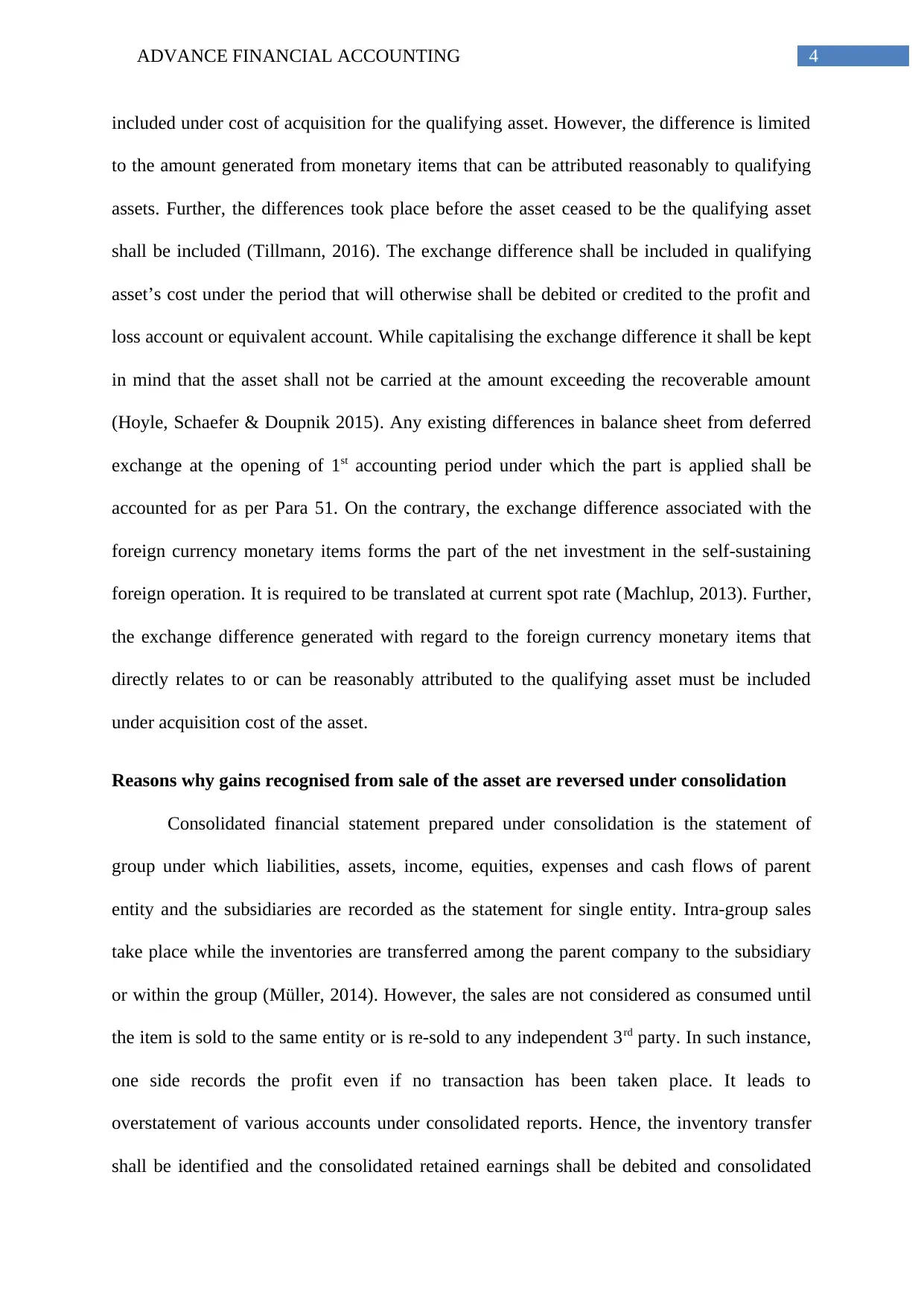
4ADVANCE FINANCIAL ACCOUNTING
included under cost of acquisition for the qualifying asset. However, the difference is limited
to the amount generated from monetary items that can be attributed reasonably to qualifying
assets. Further, the differences took place before the asset ceased to be the qualifying asset
shall be included (Tillmann, 2016). The exchange difference shall be included in qualifying
asset’s cost under the period that will otherwise shall be debited or credited to the profit and
loss account or equivalent account. While capitalising the exchange difference it shall be kept
in mind that the asset shall not be carried at the amount exceeding the recoverable amount
(Hoyle, Schaefer & Doupnik 2015). Any existing differences in balance sheet from deferred
exchange at the opening of 1st accounting period under which the part is applied shall be
accounted for as per Para 51. On the contrary, the exchange difference associated with the
foreign currency monetary items forms the part of the net investment in the self-sustaining
foreign operation. It is required to be translated at current spot rate (Machlup, 2013). Further,
the exchange difference generated with regard to the foreign currency monetary items that
directly relates to or can be reasonably attributed to the qualifying asset must be included
under acquisition cost of the asset.
Reasons why gains recognised from sale of the asset are reversed under consolidation
Consolidated financial statement prepared under consolidation is the statement of
group under which liabilities, assets, income, equities, expenses and cash flows of parent
entity and the subsidiaries are recorded as the statement for single entity. Intra-group sales
take place while the inventories are transferred among the parent company to the subsidiary
or within the group (Müller, 2014). However, the sales are not considered as consumed until
the item is sold to the same entity or is re-sold to any independent 3rd party. In such instance,
one side records the profit even if no transaction has been taken place. It leads to
overstatement of various accounts under consolidated reports. Hence, the inventory transfer
shall be identified and the consolidated retained earnings shall be debited and consolidated
included under cost of acquisition for the qualifying asset. However, the difference is limited
to the amount generated from monetary items that can be attributed reasonably to qualifying
assets. Further, the differences took place before the asset ceased to be the qualifying asset
shall be included (Tillmann, 2016). The exchange difference shall be included in qualifying
asset’s cost under the period that will otherwise shall be debited or credited to the profit and
loss account or equivalent account. While capitalising the exchange difference it shall be kept
in mind that the asset shall not be carried at the amount exceeding the recoverable amount
(Hoyle, Schaefer & Doupnik 2015). Any existing differences in balance sheet from deferred
exchange at the opening of 1st accounting period under which the part is applied shall be
accounted for as per Para 51. On the contrary, the exchange difference associated with the
foreign currency monetary items forms the part of the net investment in the self-sustaining
foreign operation. It is required to be translated at current spot rate (Machlup, 2013). Further,
the exchange difference generated with regard to the foreign currency monetary items that
directly relates to or can be reasonably attributed to the qualifying asset must be included
under acquisition cost of the asset.
Reasons why gains recognised from sale of the asset are reversed under consolidation
Consolidated financial statement prepared under consolidation is the statement of
group under which liabilities, assets, income, equities, expenses and cash flows of parent
entity and the subsidiaries are recorded as the statement for single entity. Intra-group sales
take place while the inventories are transferred among the parent company to the subsidiary
or within the group (Müller, 2014). However, the sales are not considered as consumed until
the item is sold to the same entity or is re-sold to any independent 3rd party. In such instance,
one side records the profit even if no transaction has been taken place. It leads to
overstatement of various accounts under consolidated reports. Hence, the inventory transfer
shall be identified and the consolidated retained earnings shall be debited and consolidated
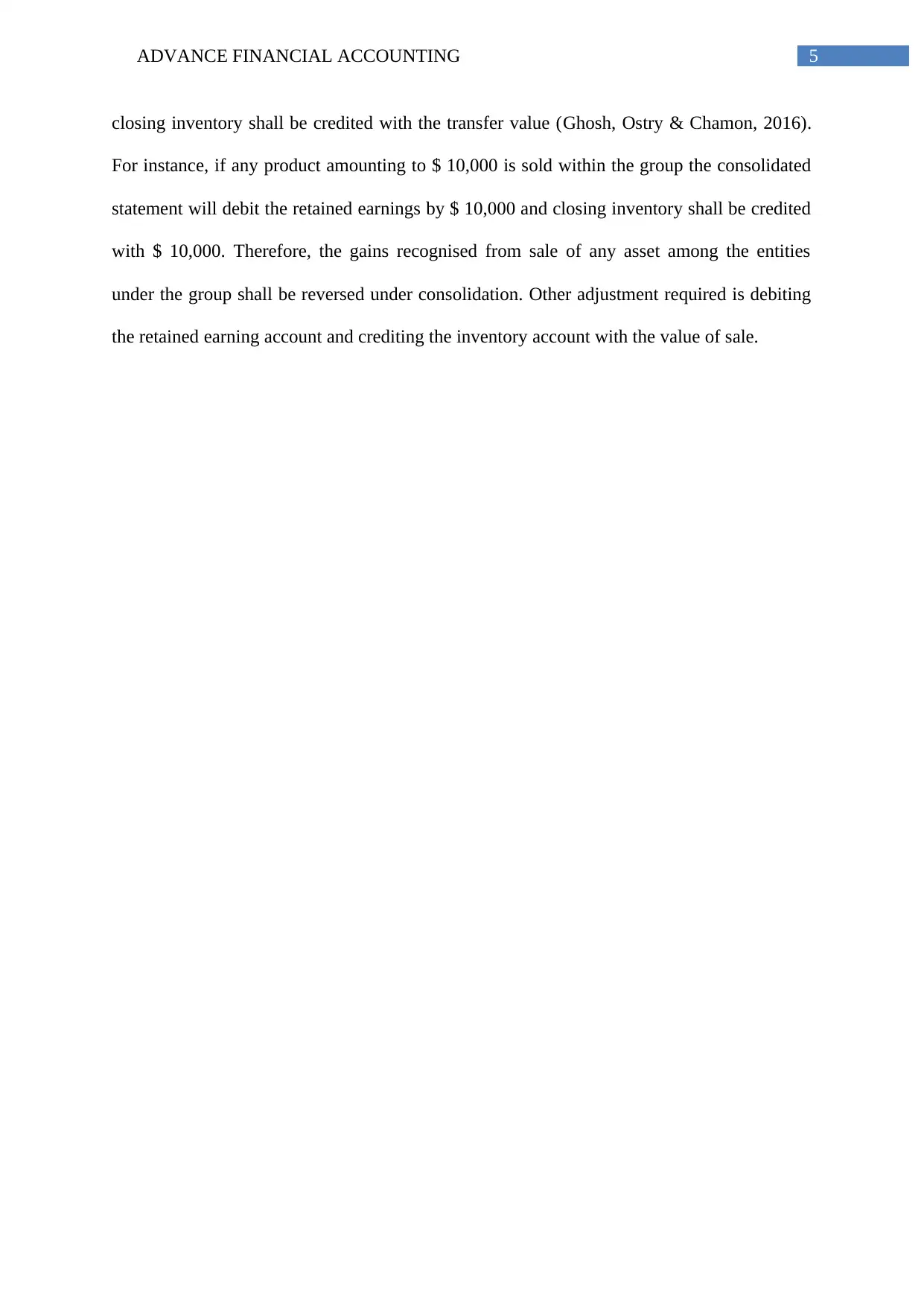
5ADVANCE FINANCIAL ACCOUNTING
closing inventory shall be credited with the transfer value (Ghosh, Ostry & Chamon, 2016).
For instance, if any product amounting to $ 10,000 is sold within the group the consolidated
statement will debit the retained earnings by $ 10,000 and closing inventory shall be credited
with $ 10,000. Therefore, the gains recognised from sale of any asset among the entities
under the group shall be reversed under consolidation. Other adjustment required is debiting
the retained earning account and crediting the inventory account with the value of sale.
closing inventory shall be credited with the transfer value (Ghosh, Ostry & Chamon, 2016).
For instance, if any product amounting to $ 10,000 is sold within the group the consolidated
statement will debit the retained earnings by $ 10,000 and closing inventory shall be credited
with $ 10,000. Therefore, the gains recognised from sale of any asset among the entities
under the group shall be reversed under consolidation. Other adjustment required is debiting
the retained earning account and crediting the inventory account with the value of sale.
⊘ This is a preview!⊘
Do you want full access?
Subscribe today to unlock all pages.

Trusted by 1+ million students worldwide
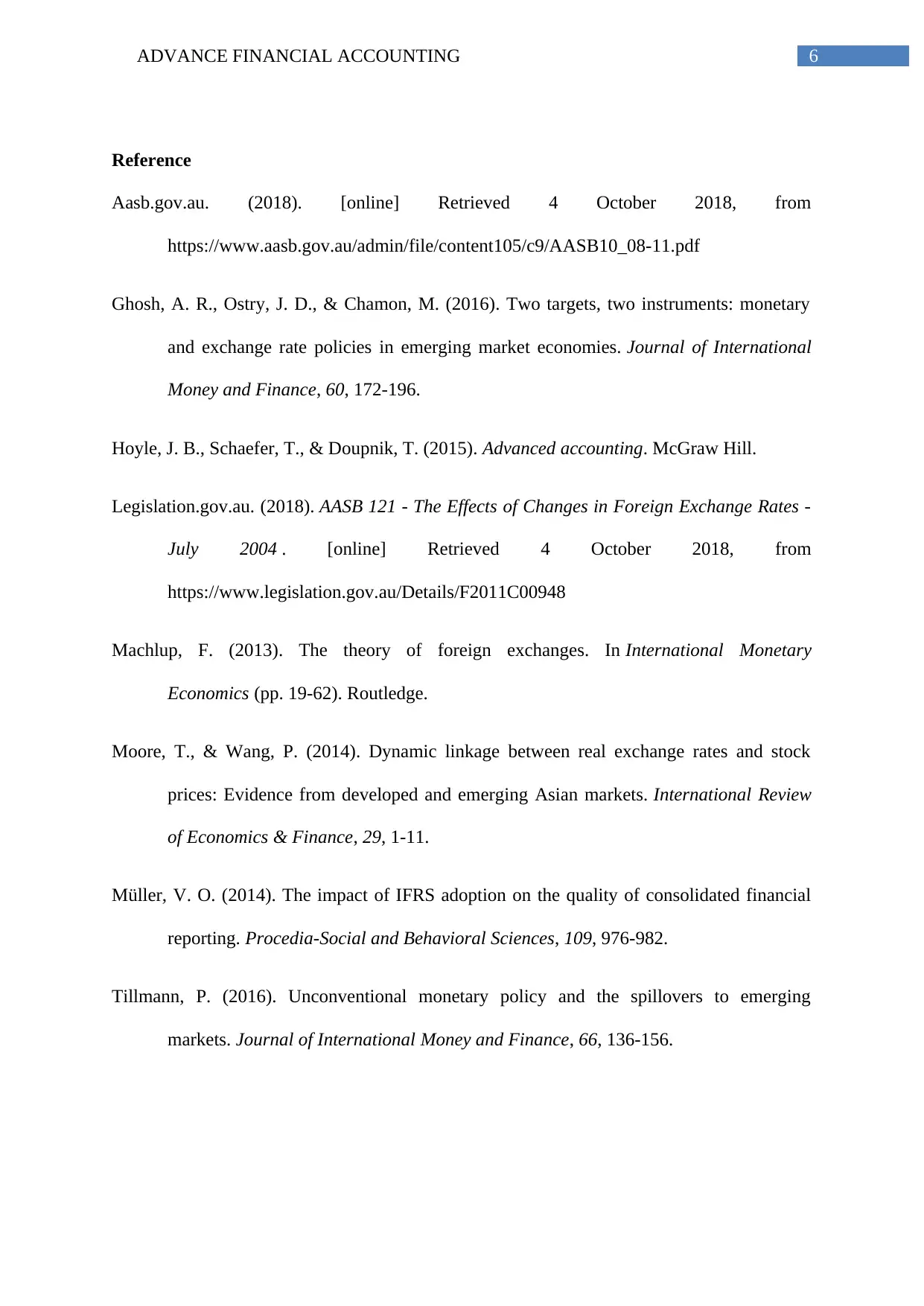
6ADVANCE FINANCIAL ACCOUNTING
Reference
Aasb.gov.au. (2018). [online] Retrieved 4 October 2018, from
https://www.aasb.gov.au/admin/file/content105/c9/AASB10_08-11.pdf
Ghosh, A. R., Ostry, J. D., & Chamon, M. (2016). Two targets, two instruments: monetary
and exchange rate policies in emerging market economies. Journal of International
Money and Finance, 60, 172-196.
Hoyle, J. B., Schaefer, T., & Doupnik, T. (2015). Advanced accounting. McGraw Hill.
Legislation.gov.au. (2018). AASB 121 - The Effects of Changes in Foreign Exchange Rates -
July 2004 . [online] Retrieved 4 October 2018, from
https://www.legislation.gov.au/Details/F2011C00948
Machlup, F. (2013). The theory of foreign exchanges. In International Monetary
Economics (pp. 19-62). Routledge.
Moore, T., & Wang, P. (2014). Dynamic linkage between real exchange rates and stock
prices: Evidence from developed and emerging Asian markets. International Review
of Economics & Finance, 29, 1-11.
Müller, V. O. (2014). The impact of IFRS adoption on the quality of consolidated financial
reporting. Procedia-Social and Behavioral Sciences, 109, 976-982.
Tillmann, P. (2016). Unconventional monetary policy and the spillovers to emerging
markets. Journal of International Money and Finance, 66, 136-156.
Reference
Aasb.gov.au. (2018). [online] Retrieved 4 October 2018, from
https://www.aasb.gov.au/admin/file/content105/c9/AASB10_08-11.pdf
Ghosh, A. R., Ostry, J. D., & Chamon, M. (2016). Two targets, two instruments: monetary
and exchange rate policies in emerging market economies. Journal of International
Money and Finance, 60, 172-196.
Hoyle, J. B., Schaefer, T., & Doupnik, T. (2015). Advanced accounting. McGraw Hill.
Legislation.gov.au. (2018). AASB 121 - The Effects of Changes in Foreign Exchange Rates -
July 2004 . [online] Retrieved 4 October 2018, from
https://www.legislation.gov.au/Details/F2011C00948
Machlup, F. (2013). The theory of foreign exchanges. In International Monetary
Economics (pp. 19-62). Routledge.
Moore, T., & Wang, P. (2014). Dynamic linkage between real exchange rates and stock
prices: Evidence from developed and emerging Asian markets. International Review
of Economics & Finance, 29, 1-11.
Müller, V. O. (2014). The impact of IFRS adoption on the quality of consolidated financial
reporting. Procedia-Social and Behavioral Sciences, 109, 976-982.
Tillmann, P. (2016). Unconventional monetary policy and the spillovers to emerging
markets. Journal of International Money and Finance, 66, 136-156.
1 out of 7
Related Documents
Your All-in-One AI-Powered Toolkit for Academic Success.
+13062052269
info@desklib.com
Available 24*7 on WhatsApp / Email
![[object Object]](/_next/static/media/star-bottom.7253800d.svg)
Unlock your academic potential
Copyright © 2020–2025 A2Z Services. All Rights Reserved. Developed and managed by ZUCOL.





